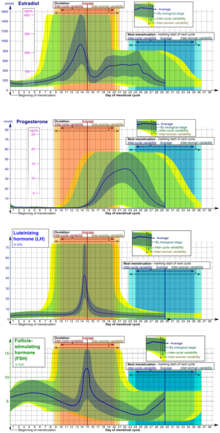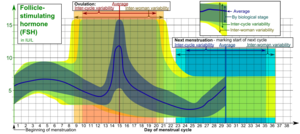| OpisHormones estradiol, progesterone, LH and FSH during menstrual cycle.svg |
English: Reference ranges for the blood content of the hormones estradiol (the main estrogen), progesterone, follicle-stimulating hormone and luteinizing hormone during the menstrual cycle.
As a rule of thumb, the narrower ranges may be used when more is known about the individual woman.
Interpretation
The x-axis shows the time of the menstrual cycle in days. The time scale starts with the beginning (or "onset") of (last) menstrual period (LMP), given as day number. Day number 1 corresponds to 0 to 0.99 days from LMP, and Day number 2 corresponds to 1.00 to 1.99 days from LMP and so forth. The time scale ends at whatever is the actual next menstruation, which marks the beginning of the next cycle, which is equivalent to starting all over again from the beginning of the time scale. The diagram accounts for multiple mechanisms of variability. For the time scale, these are:
- Inter-cycle (also called within-woman or intrawoman) variability for ovulation and next menstruation are the 95% prediction intervals for the timing of these events in any single woman, assuming an inter-cycle average duration that is equal to population average.
- Inter-woman variability for ovulation and next menstruation are the 95% prediction intervals for the timing of these events in the overall population. It also accounts for variability in cycle durations between women, where even the average cycle durations of any individual woman is often shorter or longer than the average.
Hormone levels represent usual ones, not necessarily related to what is healthy. Hormone ranges vary between cases at the same biological stage of the menstrual cycle. Furthermore, the actual timing (usually given in day numbers from mentruation) of that biological stage varies, both between cycles of any single woman (inter-cycle) and between somen (inter-woman). Therefore, the appropriate ranges to use depend on how certain the actual biological stage can be estimated at any time.
- The ranges denoted By biological stage are the 90% prediction intervals for hormone levels for women at the same biological stage. These reference ranges may be used in closely monitored menstrual cycles in regard to other markers of its biological progression, with the time scale being compressed or stretched to how much faster or slower, respectively, the cycle progresses compared to an average cycle. In the luteal phase, a known time of ovulation is sufficient to use these ranges.
- The ranges denoted Inter-cycle variability (also called within-woman or intrawoman variability) are the up to 95% prediction intervals for any single woman, assuming an inter-cycle average duration that is equal to population average. These ranges are more appropriate to use in non-monitored cycles with only the beginning of menstruation known, but where the woman accurately knowing her average cycle lengths and time of ovulation, and that they are somewhat averagely regular, with the time scale being compressed or stretched to how much a woman's average cycle length is shorter or longer, respectively, than the average of the population.
- The ranges denoted Inter-woman variability are the up to 95% prediction intervals for hormone levels in the overall population. These ranges are more appropriate in non-monitored cycles, where the average cycle lengths and time of ovulation are unknown, but only the beginning of menstruation is given.
Derivation
See source article:
|



















